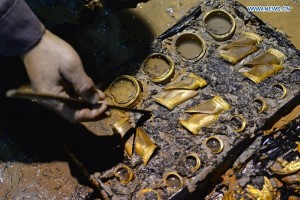Gold Coins and "Hooves" Found in Another Ancient Chinese Tomb
About a week ago, a fantastic cache of copper coins—literally millions of them—were uncovered in the royal tomb of an Ancient Chinese Marquis. Although the items uncovered in the millennia-old burial site are rich in cultural and historical value, the copper composition and sheer volume of the coins made them more an academic oddity than a treasure hunter's dream.
The find did, however, spark more interest in the potential discovery of rare and valuable artifacts from Ancient China's Western Han Dynasty (206 BCE - 24 CE). Sure enough, archaeologists have now struck gold in the very same tomb (or at least the same cemetery).
Ancient Aristocratic Burial Ground
Like the giant piles of copper coins (weighing 20,000 pounds!) found earlier in November, the array of gold items were recovered from the tomb of an Ancient Chinese aristocrat, the Marquis of Haihun, given the title "Haihunhou." He is believed to have been the emperor's nephew.
The burial site covers an impressive 40,000 square meters, and even includes tombs for the horses that pulled royal chariots. The site has been in the long and delicate process of excavation for the past 5 years.
Gold Hooves?
The gold items were located in boxes beneath the marquis's entombed bed, and are believed to have been gifts or awards from the emperor. It stands as by far the largest gold hoard ever found in a royal tomb that dates to the Han Dynasty.
Included in the cache of riches were 50 gold coins and 25 gold ingots, each weighing roughly 250 grams (more than 8 troy ounces!), although some of the ingots were closer to 1.5 oz. Interestingly, the ingots are "hoof-shaped." It's unlikely that they were actual horseshoes or used for any similar purpose. The best bet is that they were merely ornamental. (The Ancient Chinese had a penchant for casting bronze, copper, and gold ingots in all kinds of interesting shapes.)
You can find a few more images from the historic find here.


